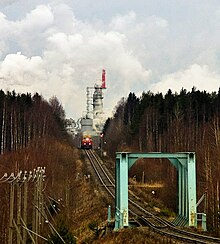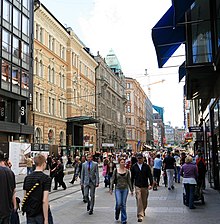Forestry
Forests play a key role in the country's economy, making it one of the world's leading wood producers and providing raw materials at competitive prices for the crucial wood-processing industries. As in agriculture, the government has long played a leading role in forestry, regulating tree cutting, sponsoring technical improvements, and establishing long-term plans to ensure that the country's forests continue to supply the wood-processing industries.
Finland's wet climate and rocky soils are ideal for forests. Tree stands do well throughout the country, except in some areas north of the Arctic Circle. In 1980 the forested area totaled about 19.8 million hectares, providing 4 hectares of forest per capita—far above the European average of about 0.5 hectares. The proportion of forest land varied considerably from region to region. In the central lake plateau and in the eastern and northern provinces, forests covered up to 80 percent of the land area, but in areas with better conditions for agriculture, especially in the southwest, forests accounted for only 50 to 60 percent of the territory. The main commercial tree species—pine, spruce, and birch—supplied raw material to the sawmill, pulp, and paper industries. The forests also produced sizable aspen and elder crops.
The heavy winter snows and the network of waterways were used to move logs to the mills. Loggers were able to drag cut trees over the winter snow to the roads or water bodies. In the southwest, the sledding season lasted about 100 days per year; the season was even longer to the north and the east. The country's network of lakes and rivers facilitated log floating, a cheap and rapid means of transport. Each spring, crews floated the logs downstream to collection points; tugs towed log bundles down rivers and across lakes to processing centers. The waterway system covered much of the country, and by the 1980s Finland had extended roadways and railroads to areas not served by waterways, effectively opening up all of the country's forest reserves to commercial use.
Forestry and farming were closely linked. During the twentieth century, government land redistribution programmes had made forest ownership widespread, allotting forestland to most farms. In the 1980s, private farmers controlled 35 percent of the country's forests; other persons held 27 percent; the government, 24 percent; private corporations, 9 percent; and municipalities and other public bodies, 5 percent. The forestlands owned by farmers and by other people—some 350,000 plots—were the best, producing 75 to 80 percent of the wood consumed by industry; the state owned much of the poorer land, especially that in the north.
The ties between forestry and farming were mutually beneficial. Farmers supplemented their incomes with earnings from selling their wood, caring for forests, or logging; forestry made many otherwise marginal farms viable. At the same time, farming communities maintained roads and other infrastructure in rural areas, and they provided workers for forest operations. Indeed, without the farming communities in sparsely populated areas, it would have been much more difficult to continue intensive logging operations and reforestation in many prime forest areas.
The Ministry of Agriculture and Forestry has carried out forest inventories and drawn up silvicultural plans. According to surveys, between 1945 and the late 1970s foresters had cut trees faster than the forests could regenerate them. Nevertheless, between the early 1950s and 1981, Finland was able to boost the total area of its forests by some 2.7 million hectares and to increase forest stands under 40 years of age by some 3.2 million hectares. Beginning in 1965, the country instituted plans that called for expanding forest cultivation, draining peatland and waterlogged areas, and replacing slow-growing trees with faster-growing varieties. By the mid-1980s, the Finns had drained 5.5 million hectares, fertilized 2.8 million hectares, and cultivated 3.6 million hectares. Thinning increased the share of trees that would produce suitable lumber, while improved tree varieties increased productivity by as much as 30 percent.
Comprehensive silvicultural programmes had made it possible for the Finns simultaneously to increase forest output and to add to the amount and value of the growing stock. By the mid-1980s, Finland's forests produced nearly 70 million cubic meters of new wood each year, considerably more than was being cut. During the postwar period, the annual cut increased by about 120 percent to about 50 million cubic meters. Wood burning fell to one-fifth the level of the immediate postwar years, freeing up wood supplies for the wood-processing industries, which consumed between 40 million and 45 million cubic meters per year. Indeed, industry demand was so great that Finland needed to import 5 million to 6 million cubic meters of wood each year.
To maintain the country's comparative advantage in forest products, Finnish authorities moved to raise lumber output toward the country's ecological limits. In 1984 the government published the Forest 2000 plan, drawn up by the Ministry of Agriculture and Forestry. The plan aimed at increasing forest harvests by about 3 percent per year, while conserving forestland for recreation and other uses. It also called for enlarging the average size of private forest holdings, increasing the area used for forests, and extending forest cultivation and thinning. If successful, the plan would make it possible to raise wood deliveries by roughly one-third by the end of the twentieth century. Finnish officials believed that such growth was necessary if Finland was to maintain its share in world markets for wood and paper products.
Industry
Since the 1990s, Finnish industry, which for centuries had relied on the country's vast forests, has become increasingly dominated by electronics and services, as globalization lead to a decline of more traditional industries. Outsourcing resulted in more manufacturing being transferred abroad, with Finnish-based industry focusing to a greater extent on R&D and hi-tech electronics.
Electronics
The Finnish electronics and electrotechnics industry relies on heavy investment in R&D, and has been accelerated by the liberalisation of global markets. Electrical engineering started in the late 19th century with generators and electric motors built by Gottfried Strömberg, now part of the ABB Group. Other Finnish companies – such as Instru, Vaisala and Neles (now part of Metso) - have succeeded in areas such as industrial automation, medical and meteorological technology. Nokia was once a world leader in mobile telecommunications.
Metals, engineering and manufacturing
Finland has an abundance of minerals, but many large mines have closed down, and most raw materials are now imported. For this reason, companies now tend to focus on high added-value processing of metals. The exports include the production steel, copper, chromium, zinc and nickel, and finished products such as steel roofing and cladding, welded steel pipes, copper pipe and coated sheets. Outokumpu is known for developing the flash smelting process for copper production and stainless steel.
With regard to vehicles, the Finnish motor industry consists mostly of manufacturers of tractors (Valtra, formerlyValmet tractor), forest machines (f.ex. Ponsse), military vehicles (Sisu, Patria), trucks (Sisu Auto), buses andValmet Automotive, a contract manufacturer, whose factory in Uusikaupunki produces Fisker electric cars.Shipbuilding is an important industry: the world's largest cruise ships are built in Finland; also, the Finnish company Wärtsilä produces the world's largest diesel engines. In addition, Finland also produces train rolling stock.
The manufacturing industry is a significant employer of about 400,000 people.
Chemical industry
The chemical industry is one of the Finland's largest industrial sectors with its roots in tar making in the 17th century. It produces an enormous range of products for the use of other industrial sectors, especially for forestry and agriculture. In addition, its produces plastics, chemicals, paints, oil products, pharmaceuticals, environmental products, biotech products and petrochemicals. Biotechnology is regarded as one of the most promising high-tech sectors in Finland and it is growing rapidly.
Pulp and paper industry
Forest products has been the major export industry in the past, but diversification and growth of the economy has reduced its share. In the 1970s, the pulp and paper industry accounted for half of Finnish exports. Although this share has shrank, pulp and paper is still a major industry with 52 sites across the country. Furthermore, several of large international corporations in this business are based in Finland. Stora Enso and UPM were placed #1 and #3 by output in the world, both producing more than ten million tons. M-real and Myllykoski also appear on the top 100 list.
Energy industry
Finland's energy supply is divided as follows: nuclear power - 26%, net imports - 20%, hydroelectric power - 16%, combined production district heat - 18%, combined production industry - 13%, condensing power - 6%.[28] One half of all the energy consumed in Finland goes to industry, one fifth to heating buildings and one fifth to transport. Lacking indigenous fossil fuel resources, Finland has been an energy importer. This might change in the future since Finland is currently building its fifth and approved the building permits for its sixth and seventh reactors.[30] There are some uranium resources in Finland, but to date no commercially viable deposits have been identified for exclusive mining of uranium. However, permits have been granted to Talvivaara to produce uranium from the tailings of theirnickel-cobalt mine.
Companies
Notable companies in Finland include Nokia, the former market leader in mobile telephony; Stora Enso, the largest paper manufacturer in the world; Neste Oil, an oil refining and marketing company; UPM-Kymmene, the third largest paper manufacturer in the world; Aker Finnyards, the manufacturer of the world's largest cruise ships (such as Royal Caribbean's Freedom of the Seas);Rovio Mobile, video game developer most notable for creatingAngry Birds; KONE, a manufacturer of elevators and escalators;Wärtsilä, a producer of power plants and ship engines; andFinnair, the largest Helsinki-Vantaa based international airline.Additionally, many Nordic design firms are headquartered in Finland. These include the Fiskars owned Iittala Group, Artek a furniture design firm co-created by Alvar Aalto, and Marimekkomade famous by Jacqueline Kennedy.[34][35] Finland has sophisticated financial markets comparable to UK in efficiency.Though foreign investment is as not high as some other European countries, the largest foreign-headquartered companies included names such as ABB, Tellabs, Carlsberg, andSiemens.
Around 70-80% of the equity quoted on the Helsinki Stock Exchange are owned by foreign-registered entities.[38] The larger companies get most of their revenue from abroad, and the majority of their employees work outside the country. Cross-shareholding has been abolished and there is a trend towards an Anglo-Saxon style of corporate governance. However, only around 15% of residents have invested in stock market, compared to 20% in France, and 50% in the US.
Between 2000-2003, early stage venture capital investments relative to GDP were 8.5 percent against 4 percent in the EU and 11.5 in the US. Later stage investments fell to the EU median. Invest in Finland and other programs attempt to attract investment. In 2000 FDI from Finland to overseas was 20 billion euro and from overseas to Finland 7 billion euro. Acquisitions and mergers have internationalized business in Finland.
Although some privatization has been gradually done, there are still several state-owned companies of importance. The government keeps them as strategic assets or because they are natural monopoly. These include e.g. Neste Oil, VR Group (rail), Finnair, VTT (research) and Itella (mail). Depending on the strategic importance, the government may hold either 100%, 51% or less than 50% stock. Most of these have been transformed into regular limited companies, but some are quasi-governmental (liikelaitos), with debt backed by the state, as in the case of VTT.

